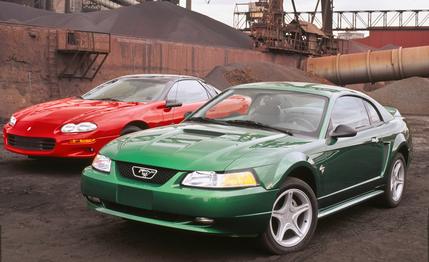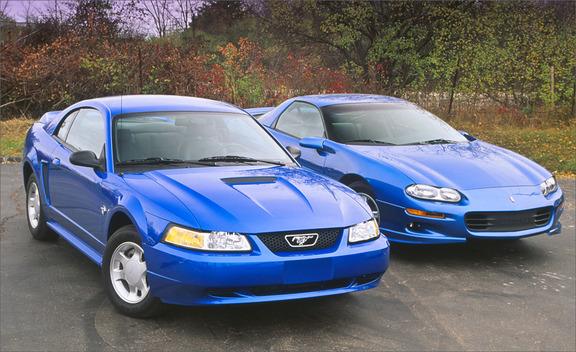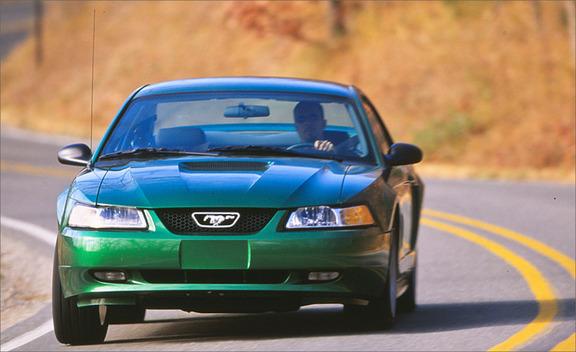
 Archived Comparison
Archived Comparison


Pony-car fans have more to be excited about today than they’ve had in 40 years—not only are both the Mustang GT and Camaro SS above the 400-hp threshold, but there’s even a horsepower war raging between the V-6 editions. Next week, we’ll post comparison tests between both the current eights and the sixes, but for now, enjoy this series of past encounters between two of Detroit’s most storied cars.
By 1999 we knew that the Camaro’s days were numbered, and we embraced what we believed might be our last chance to compare the two in February when we pitted an SS against what was at the time Ford’s best Mustang GT ever. Both cars were at the top of their game, and only three points separated winner from loser.
______________________________________
Harvard versus Yale is fine if your notion of a great American rivalry is rooted in stick-and-ball stuff. But if you’re a car guy—sorry, car person—it just doesn’t get any more all-American than Camaro vs. Mustang. On street, strip, or road circuit, this has been a renewable competitive resource since the first Camaro made its belated appearance in September of 1966. We say belated because by that time the Mustang had been on sale for almost two and a half years, and there were well over a million of ‘em galloping around America’s highways and byways.
Since then, we’ve seen these two square off in a variety of Car and Driver performance shootouts, sometimes in multicar free-for-alls. As with collegiate athletic rivalries, the players have evolved as the years have gone by. But unlike college sports, Mustang-Camaro showdowns are rarely boring.
That’s certainly true of this one, particularly if you’re a Mustang fan. It’s been more than 10 years since Ford has managed to bolt together a regular-production V-8–powered Mustang—as distinct from the limited-production versions issued by Ford’s Special Vehicle Engineering arm and marketed by the Special Vehicle Team (read: SVT Mustang Cobra)—that could hold its own in a drag race against its cross-town counterpart from Chevy. This is indeed germane, because V-8 power in a relatively lightweight two-door is the essence of the pony-car tradition, now in its 35th year. We also think this could very well be one of the last times these two rivals meet in close combat. The 2001 model year will be the last for the current General Motors F-bodies—the Camaro and the Pontiac Firebird—and at this writing, GM has no new model scheduled for the factory in Sainte-Therese, Quebec, that produces them. Predictably, Chevy insists that the Camaro name will live on, but what that name will be attached to is anybody’s guess at the moment.
Well, that’ll be then, but this is now, and what you want to know right now is which of these quarter-horses can cover the quarter the quickest. So, buckle up, bud.
Our prime combatants (the V-6s are detailed in a sidebar) were well-equipped versions of the Z28 and Mustang GT, both 1999 models. Although a base Mustang GT and a standard Z28 are priced almost identically — $21,395 versus $21,405—our testers were separated by almost $1500$24,341 for the Chevy vs. $22,855 for the Mustang, due to the Camaro’s $1591 preferred equipment package (including power goodies, remote entry, and an alarm —all standard on the Ford).
For the Camaro, 1999 isn’t much of a change from 1998. The only significant update is the Z28’s standard Zexel Torsen limited-slip differential. But it’s a different story for the ‘99 Mustang, which has undergone its first serious makeover in five years. For example, although the basic shape is familiar, almost all the skin is new, be it ferrous or nonferrous (the new rear decklid is made of sheet-molded compound, a fancy way of saying plastic, rather than sheet steel). There are bigger side scoops ahead of the rear wheel wells (although their function continues to be purely decorative), a new front fascia with wraparound headlights and an expanded grille, bigger taillamps, and sharper definition to the fender flares. The widened (by 1.4 inches) rear track brings the wheels out closer to the edges of the bodywork.


All in all, there’s an engagingly edgy look to the new package that was missing on the previous version, as well as a suggestion of more brawn to go with it. And that’s a suggestion that should be taken seriously. There are many more ponies under that resculptured hood, enough to chop the Mustang’s 0-to-60-mph time to 5.5 seconds, 0.6 second quicker than the last GT to take on a Z28 (CID, December 1993). If the Z28 hadn’t posted an improvement of its own-5.2 seconds vs. 5.4 back in ‘93—it would have been almost a dead heat.
So how’d they do that? We were less than impressed when Ford replaced the Mustang’s old 4.9-liter pushrod V-8 with the current 4.6-liter SOHO V-8 in 1996. Amid the corporate hosannas lauding technoprogress, we noted that the peak output figures for the modern new engine were exactly the same as the antiquated old one’s: 215 horsepower and 285 pound-feet of torque. Ford mined another 10 hp from the 4.6 last year, but that still seemed tame compared with the Z28’s 305 hp and 335 lb-ft of torque.


So for ‘99, Ford’s horsepower honchos got serious. The GT version of the 4.6-liter V-8 has bigger valves, higher-lift cams with longer duration, revised intake runners, and coil-on-plug ignition. Two 3.0-inch tailpipes reduce exhaust back pressure and, almost as important, lend a throaty baritone to the exhaust note, turning out the sweetest sounds we’ve heard from a Mustang since the heyday of the Boss 302.
The net-net: 260 hp at 5250 rpm, 300 lb-ft of torque at 4000. That increase, plus a lower 3.27:1 rear-axle ratio—standard on all ‘99 Mustangs—accounts for the GT’s ability to stay close to its more powerful rival in short sprints. And it’s a big factor in the near-photo-finish scoring of these two. But not the only factor.

